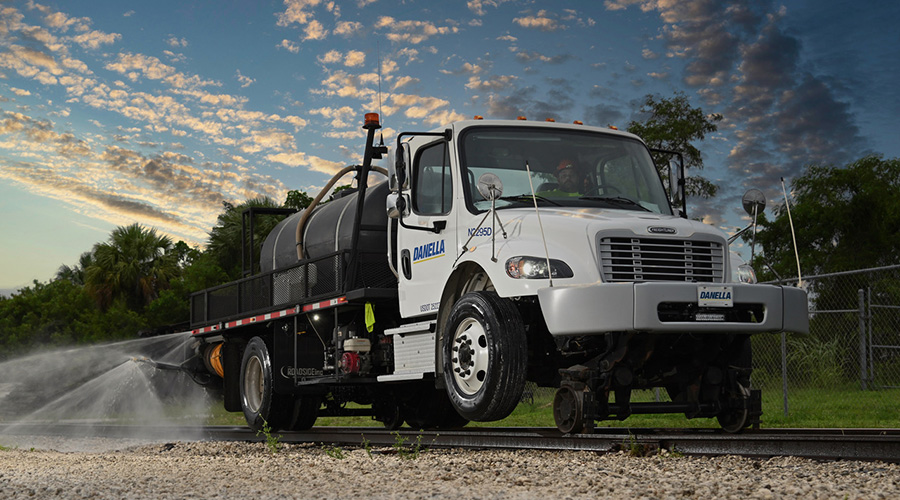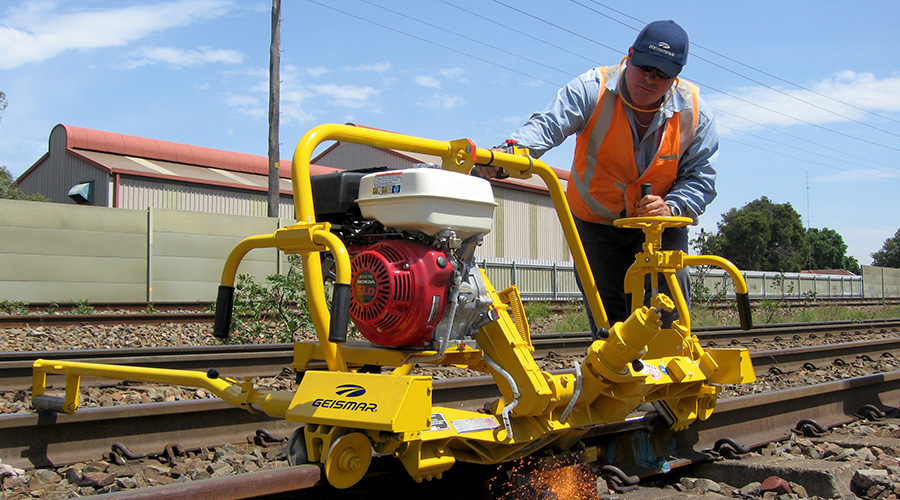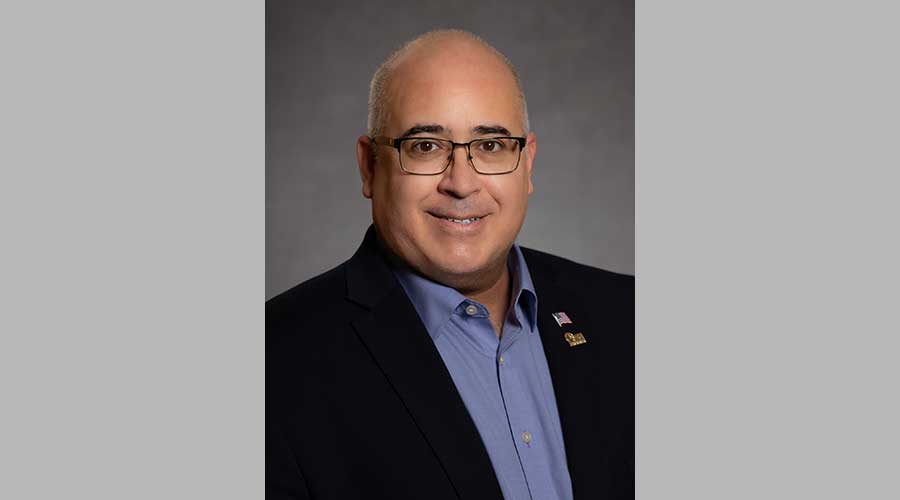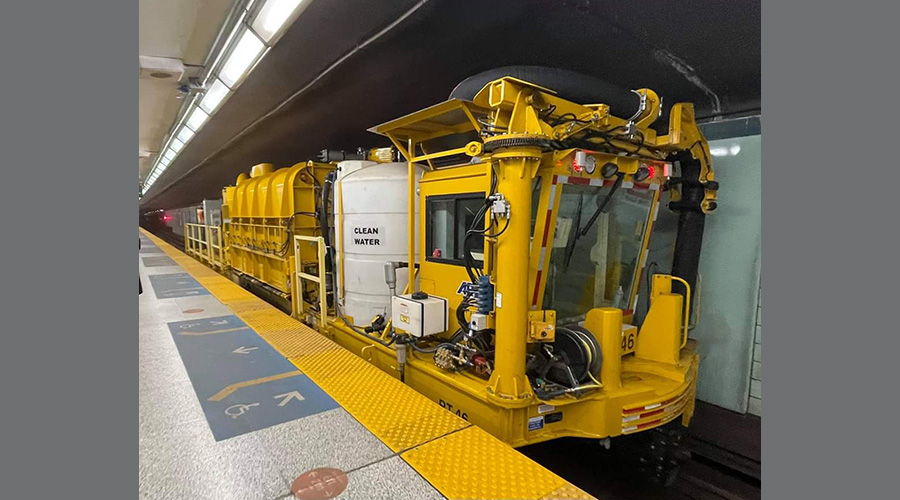Stay updated on news, articles and information for the rail industry
June 2012
Rail News: MOW
Rail grinding equipment update 2012
— by William Atkinson
Rail grinding equipment manufacturers know what their customers want: machines that feature faster speeds, better environmental controls, and improved ergonomics and operator safety. And as ever, productivity is key: Maintenance-of-way officials expect the grinding equipment they use to be highly efficient. Overall, they're using it more often these days, some suppliers say.
"We are starting to see renewed interest in grinding, in general, among railroads," said Alan Reynolds, general sales manager for Modern Track Machinery Inc. "Some of them are grinding their switches religiously. Others used to have switch gangs out there to do preventive maintenance. ... I think the trend may be for additional gangs to be added. In other words, railroads are seeing the value and rewards of the maintenance."
Particularly when it's performed efficiently.
To that end, grinding equipment manufacturers are offering an array of machines with a host of features.
For example, Vossloh Rail Services offers milling and high-speed grinding (HSG) equipment, the latter providing working speeds of more than 50 mph. The company's milling technology enables work to take place under "restrictive" circumstances; the HSG machine enables work to be maintained within the confines of traffic, said Vice President and General Manager Ron Martin.
With the milling head's new design, the system can achieve the required profile in a single pass, as well as operate at twice the speed of previous units and similar technologies.
"We have been able to put an additional function on this that will help to reprofile the gauge face of the rail," Martin said.
Next-Generation Equipment
Meanwhile, the HSG equipment "will maintain the profile without disruption to traffic," Martin said. "The HSG is the only system that can work in train slots and under schedule to minimize traffic disruptions. This allows for more frequent maintenance grinding, decreased required corrective grinding and less degradation to the rail due to head checks between cycles."
Vossloh also has developed a next-generation HSG-2, which features a vacuum system that collects almost 100 percent of all rail filings, Martin said, adding that the first-generation system kept most of the filings generated well inside the ballast line. The HSG-2 also is safer.
"The biggest benefit [of HSG-2] is spark mitigation," he said. "In any grinding application, people are scared to death of potential fires. With the new vacuum system we developed for the HSG-2, it has completely mitigated any spark or fire potential."
Vossloh also offers a total Rail Life Management system, which is a combination of rail milling and HSG technologies.
"The total Rail Life Management system is a model we have been working on for awhile," said Martin. "However, we have only recently been in the position to implement it, or at least consider implementation of it. We are getting good feedback. We are waiting for some commitments from three railroads to bring the HSG machine over [to the United States]. We are hoping to have it on the ground in the U.S. later in 2012."
Multifaceted Machines
Meanwhile, Loram Maintenance of Way Inc. offers the RG400 Series of production rail grinders, which company officials say offer improved rail grinding speed, performance and reliability. The grinders also provide increased available horsepower, advanced grind control systems, more stones and higher grind speeds (up to 20 mph), and deeper angle cutting capabilities to address various rail conditions.
Other features include an improved traction system; a horsepower control system designed to facilitate consistent metal removal; auto machine lubrication to reduce maintenance and enhance machine accuracy; high-capacity walk-around water cars that provide improved fire suppression and a safer work environment; and state-of-the-art rail measurement and vision systems.
Loram offers five mainline grinders (soon to be six) in North America, ranging in size from 90 to 120 stones.
"These are much more productive than our traditional 88-stone rail grinders," said Manager of Marketing and Business Development Joe Ashley. "Customers are able to get more done in a day, thus lowering their unit costs. When building these, we really focused on the environmental aspects, since rail grinding can have some negative impacts on the environment. We wanted to minimize those as much as possible. To that end, we installed engines designed to lower the emissions."
Loram also installed an integrated auxiliary generator on the grinder, enabling main engine shut-off during maintenance, or when the equipment is sitting in the sidings on train delay. The result: fuel savings, Ashley said.
"Also, on the environmental side, we utilize hydraulic fluid that is non-flammable water glycol," he added.
Loram also has stepped it up on the fire suppression front.
"We can keep the sparks in the track bed through better spark controls," Ashley said. "If they do escape, we have improved firefighting ability on the machine, as well as more water available for firefighting. Some of our grinders carry up to 75,000 gallons of water."
Loram's 400 series platform also is available as a specialty grinder with 24 to 48 stones.
"We currently have two, and are building more," Ashley said. "They produce similar results with higher productivity and lower unit costs."
In addition to the RG400 Series, Loram offers the RGS Specialty Grinder, a 24-stone machine driven by 30-horsepower electric motors, enabling it to grind a switch or crossing in fewer passes than other specialty grinders, according to the company. It can grind a complete switch in six to nine minutes and achieve speeds of up to 12 mph during open-rail grinding.
The RGS Specialty Grinder also incorporates a filtration system designed to mitigate effects on the environment. It uses flame-resistant hydraulic fluid and is equipped with spark guards that retain grinding sparks within the confines of the track structure. The grinder also includes 4,500 gallons of water for fire protection.
Modern Track Machinery also offers a specialty grinder: the MP23 profile grinder, which was unveiled about two years ago.
"A lot of the design was done with ergonomics for the operator in mind, [reducing] stress in terms of bending over," Reynolds noted. "The in-track welders produce a large number of welds per day. We are getting feedback from the workers that they aren't feeling the fatigue at the end of the day as they did with the traditional profile grinders."
The company also supplies the MC-3A, which features a Honda engine and can grind frogs, switch points and stock rails. There's also a hydraulic version, the MC-3A-H.
The pivoting grinding assembly permits alignment of the grindstone parallel to stock rail for full grindstone-to-rail contact. The mobile grinding assembly and engine are carried in an intermediate trolley, which is fitted with four deep-grooved rollers inclined at 45 degrees, running on the frame of the undercarriage.
"The MC-3A is specific for frog and switch grinding, where you have overflow," Reynolds said. "If you are doing routine maintenance, we have found that there is a savings in that it extends the life of the trackwork, switchpoints, etc. You don't have overflow, which can be broken off and either rebuild it or replace the switchpoint."
Railtech Matweld Inc., too, is focusing on ergonomics. The company's Precision Frog Grinder can target the area and grind while standing upright, which keeps the operators out of the harmful grinding dust, said Assistant Vice President, and Sales and Marketing Director Alex Hellkamp. The grinder also provides consistent, repeatable grinding results, he added.
"This is particularly important with so many new hires coming into the industry," Hellkamp said.
The ergonomic design also helps prevent operator back strain and fatigue.
"Our profile grinder and multi-purpose grinder used in combination permit the grinding of rail welds, while allowing operators to maintain upright standing positions," Hellkamp said. "Maintaining an ergonomic stance reduces bending and back strain."
Feedback For A Better Fit
Railtech Matweld also has been focusing on improving spark reduction in the grinding process. For help, they've solicited feedback from customers, Hellkamp said.
Officials at Racine Railroad Products Inc. — which offers a variety of portable gas, electric and hydraulic powered grinders, used mostly by welding crews — taps customers for insights and input, as well.
"Our principal goal is to design and manufacture safe, reliable and productive equipment by seeking feedback from our customers in order to make the grinders fit their needs better," said National Sales Manager Steve Ries.
The company's hydraulic models include a Back Handle Grinder, which features a patented ergonomic handle for ease of use and less operator fatigue, company officials said in an email. Used for grinding switch and frog points, the lighter-weight Cup Stone Grinder and Right Angle Grinder feature a Gerotor-style motor and offer longer equipment life and less maintenance, the company said.
A Bull-Nose Grinder for chamfering bolt holes is designed to prevent rail defects from stress risers. When using the company's Stand-Up Web Grinder, operators don't have to bend over when grinding rail web.
And the company's Rail Profile Grinder offers "excellent spark deflection" and an ergonomic safety trigger to prevent unplanned use, the company said.
Racine Rail Products' gas models include a Rail Profile Grinder (also available in an electric model), which has the weight necessary for more productive rail grinding, reducing grinding time and operator fatigue, the company said. Also available is a lightweight Gas Utility Grinder that can be used for either chamfering bolt holes (with a bull-nose stone) or web grinding and de-burring applications with a six-inch diameter grindstone.
The company also offers a variety of other gas, electric and hydraulic portable hand tools, which are available for on-site demonstration through an "extensive nationwide sales network," the company said.
William Atkinson is a Carterville, Ill.-based free-lance writer.


 LRW Honors Amtrak’s Acheson As Railway Woman Of The Year
LRW Honors Amtrak’s Acheson As Railway Woman Of The Year
 From Editor-In-Chief Foran: Of Gender Equity And Inclusion
From Editor-In-Chief Foran: Of Gender Equity And Inclusion
 Spotlight On Some Of Today’s Rail Safety Products
Spotlight On Some Of Today’s Rail Safety Products
 Women of Influence in Rail eBook
Women of Influence in Rail eBook
 railPrime
railPrime








